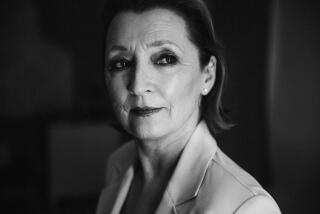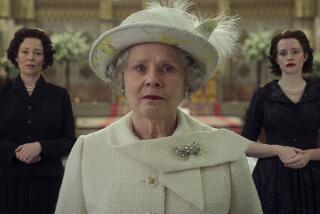Fit for a ‘Queen’: The royal drama after Di’s death
- Share via
Go ahead, admit it. Between the kerchiefs and the corgis, the sensible clothes and the semi-detached smile, Britain’s Queen Elizabeth II has never been mistaken for the most dramatic monarch in the world, never given much of a hint that there might be a Major Motion Picture in her life.
But this immovable object has met the unstoppable force that is actress Helen Mirren, one of the great masters of modern screen acting. In a commanding performance that is as compelling as it is unexpected, she has turned “The Queen” into something you never imagined it could be: a crackling dramatic story that’s intelligent, thoughtful and moving.
Of course, Mirren has had help, starting with top-of-the-line director Stephen Frears, one of Britain’s most gifted, a filmmaker capable, in works as varied as “My Beautiful Laundrette,” “The Grifters,” “High Fidelity” and “Dirty Pretty Things,” of bringing insight and faultless professionalism to projects without seeming to break a sweat.
“The Queen” also has a strong script by Peter Morgan (“The Last King of Scotland”) about a particularly poignant and significant moment in recent British history, the death of Princess Diana and the divergent and potentially ruinous ways the monarch and Prime Minister Tony Blair responded to the resulting torrent of national grief.
Morgan, Frears and costar Michael Sheen (who plays Blair) had the advantage of working together on a previous made-for-British-TV film called “The Deal,” about the relationship between the PM and his Labor Party rival Gordon Brown. But here they’ve added Mirren to the mix, with exceptional results.
It’s not just that the actress manages from her first moment to uncannily resemble the queen, who here looks unaccountably like Gilbert Stuart’s portrait of George Washington. It’s that Mirren has so invested her own formidable presence and astuteness in the character that the monarch’s self-possession, shrewdness and sense of command become self-evident and involving.
Mirren has also helped make the queen a person with a droll, martini-dry but unmistakable sense of humor. She’s introduced posing for a portrait on Britain’s election day and telling the painter, “I envy you being able to vote: the sheer joy of being partial.” Later, when she first meets a tongue-tied Blair, she archly comments, “If you agree, the custom is to say yes.”
Most of “The Queen” takes place during the week following the Aug. 31, 1997, death of the princess of Wales, and one of its accomplishments, courtesy of adroit use of newsreel and other contemporary footage, is to remind us of the deep sadness that surrounded that event.
Blair, the newly minted prime minister, immediately understands the effect the death will have on the mood of the country and, with his “the people’s princess” speech, promptly capitalizes on it.
The queen, on the other hand, hampered by a lack of rapport with Diana and her own personal style, neither understands the public mood nor responds to it. An intensely reserved person whose watchwords are “restrained grief and sober private mourning,” she sets her jaw in disapproval and disappears into the leafy fastness of Scotland’s Balmoral Castle, resistant to every suggestion of a royal public response to the death. Blair thinks this is a mistake and is not shy about saying so.
Because much of “The Queen” is a back and forth between what is going on with the monarch and her entourage (including James Cromwell as crusty Prince Philip and Sylvia Syms as the queen mother) and the PM and his (led by Helen McCrory as his snitty anti-monarchist wife, Cherie), Frears came up with the intriguing idea of shooting the royal family scenes in 35-millimeter and the ones surrounding Blair with the less grand Super 16.
Some of what happened during this critical week is public record, but screenwriter Morgan, utilizing what the press material poetically characterizes as “extensive interviews, devoted research, discreet sources and informed imagination,” has done an expert job fleshing out the time that was private in a way that feels both juicy and respectful, like a “Masterpiece Theatre” version of reality TV.
Morgan’s script also underlines why this difference of opinion about Diana was both significant and dramatic. Because of a shift in values she does not understand, for the first time in her reign Elizabeth was faced with a situation in which what the nation needed ran contrary to what her emotions said she should be doing. It’s a conflict that placed the monarchy in jeopardy and points up why “The Queen” starts with the famous “uneasy lies the head that wears a crown” reference from Shakespeare’s “Henry IV, Part 2.”
As the actress who wears that crown, it is Mirren (Oscar nominated for “The Madness of King George” and “Gosford Park”) who must pull all this together, and she does it beautifully. Her Elizabeth is an intriguing combination, an intensely private person yet mistress of all she surveys. Being queen is a job she never wanted but has gotten quite good at, so rethinking it is definitely not on her agenda. She understands that grand theatrical gestures are part of the assignment, but it is Mirren’s gift to insist we see and value not just the performer but the person who lives inside.
*
‘The Queen’
MPAA rating: PG-13 for brief strong language
A Miramax Films release. Director Stephen Frears. Writer Peter Morgan. Producers Andy Harries, Christine Langan, Tracey Seaward. Director of photography Affonso Beato. Editor Lucia Zucchetti. Running time: 1 hour, 43 minutes.
Exclusively at Pacific’s ArcLight, 6360 W Sunset Blvd. (at Ivar Avenue), (323) 464-4226; Laemmle’s Royal, 11523 Santa Monica Blvd., (310) 477-5581.
More to Read
Only good movies
Get the Indie Focus newsletter, Mark Olsen's weekly guide to the world of cinema.
You may occasionally receive promotional content from the Los Angeles Times.











